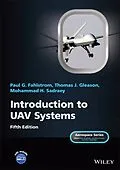Introduction to UAV Systems
The latest edition of the leading resource on unmanned aerial vehicle systems
In the newly revised Fifth Edition of Introduction to UAV Systems, an expert team of aviators, engineers, and researchers delivers the fundamentals of UAV systems for both professionals and students in UAV courses. Suitable for students in Aerospace Engineering programs, as well as Flight and Aeronautics programs, this new edition now includes end-of-chapter questions and online instructor ancillaries that make it an ideal textbook.
As the perfect complement to the author's Design of Unmanned Aerial Systems, this book includes the history, classes, and missions of UAVs. It covers fundamental topics, like aerodynamics, stability and control, propulsion, loads and structures, mission planning, payloads, and communication systems. Brand-new materials in areas including autopilots, quadcopters, payloads, and ground control stations highlight the latest industry technologies.
The authors also discuss:
* A thorough introduction to the history of unmanned aerial vehicles, including their use in various conflicts, an overview of critical UAV systems, and the Predator/Reaper
* A comprehensive exploration of the classes and missions of UAVs, including several examples of UAV systems, like Mini UAVs, UCAVs, and quadcopters
* Practical discussions of air vehicles, including coverage of topics like aerodynamics, flight performance, stability, and control
* In-depth examinations of propulsion, loads, structures, mission planning, control systems, and autonomy
Perfect for professional aeronautical and aerospace engineers, as well as students and instructors in courses like Unmanned Aircraft Systems Design and Introduction to Unmanned Aerial Systems, Introduction to UAV Systems is an indispensable resource for anyone seeking coverage of the latest industry advances and technologies in UAV and UAS technology.
Autorentext
The late Paul G. Fahlstrom was a Naval Aviator (Marine Pilot) who held positions at NASA's Goddard Space Flight Center and the Department of Transportation.
The late Thomas J. Gleason, PhD was Founder of Gleason Research Associates, an engineering and scientific analysis firm conducting evaluations related to missile and sensor systems.
Mohammad H. Sadraey is Associate Professor of Aeronautical Engineering at Southern New Hampshire University. He has authored five books, including Aircraft Design: A Systems Engineering Approach and Aircraft Performance Analysis.
Zusammenfassung
Introduction to UAV Systems
The latest edition of the leading resource on unmanned aerial vehicle systems
In the newly revised Fifth Edition of Introduction to UAV Systems, an expert team of aviators, engineers, and researchers delivers the fundamentals of UAV systems for both professionals and students in UAV courses. Suitable for students in Aerospace Engineering programs, as well as Flight and Aeronautics programs, this new edition now includes end-of-chapter questions and online instructor ancillaries that make it an ideal textbook.
As the perfect complement to the author's Design of Unmanned Aerial Systems, this book includes the history, classes, and missions of UAVs. It covers fundamental topics, like aerodynamics, stability and control, propulsion, loads and structures, mission planning, payloads, and communication systems. Brand-new materials in areas including autopilots, quadcopters, payloads, and ground control stations highlight the latest industry technologies.
The authors also discuss:
- A thorough introduction to the history of unmanned aerial vehicles, including their use in various conflicts, an overview of critical UAV systems, and the Predator/Reaper
- A comprehensive exploration of the classes and missions of UAVs, including several examples of UAV systems, like Mini UAVs, UCAVs, and quadcopters
- Practical discussions of air vehicles, including coverage of topics like aerodynamics, flight performance, stability, and control
- In-depth examinations of propulsion, loads, structures, mission planning, control systems, and autonomy
Perfect for professional aeronautical and aerospace engineers, as well as students and instructors in courses like Unmanned Aircraft Systems Design and Introduction to Unmanned Aerial Systems, Introduction to UAV Systems is an indispensable resource for anyone seeking coverage of the latest industry advances and technologies in UAV and UAS technology.
Inhalt
Preface
Aerospace Series List
Acknowledgments
List of Acronyms
Part One
Introduction
1. History and Overview
1.1. Overview
1.2. History
1.2.1. Early History
1.2.2. The Vietnam War
1.2.3. Resurgence
1.2.4. Joint Operations
1.2.5. Desert Storm
1.2.6. Bosnia
1.2.7. Afghanistan and Iraq
1.2.8. Long-Range Long-Endurance Operations
1.3. Overview of UAV Systems
1.3.1. Air Vehicle
1.3.2. Mission Planning and Control Station
1.3.3. Launch and Recovery Equipment
1.3.4. Payloads
1.3.5. Data Links
1.3.6. Ground Support Equipment
1.4. The Aquila
1.4.1. Aquila Mission and Requirements
1.4.2. Air Vehicle
1.4.3. Ground Control Station
1.4.4. Launch and Recovery
1.4.5. Payload
1.4.6. Other Equipment
1.4.7. Summary
1.5. Global Hawk
1.5.1. Mission Requirements and Development
1.5.2. Air Vehicle
1.5.3. Payloads
1.5.4. Communications System
1.5.5. Development Setbacks
1.5. Predator Family
1.5.1. Predator Development
1.5.2. Reaper
1.5.3. Features
1.6. Top UAV Manufacturers
1.7. Ethical Concerns of UAVs
Questions
2 Classes and Missions of UAVs
2.1. Overview
2.2. Classes of UAV Systems
2.2.1. Classification Criteria
2.2.2. Classification by Range and Endurance
2.2.3. Classification by Missions
2.2.4. The Tier System
2.3. Examples of UAVs by Size Group
2.3.1. Micro UAVs
2.3.2. Mini UAVs
2.3.3. Very Small UAVs
2.3.4. Small UAVs
2.3.5. Medium UAVs
2.3.6. Large UAVs
2.4. Expendable UAVs
Questions
Part Two
The Air Vehicle
3 Aerodynamics
3.1. Overview
3.2. Aerodynamic Forces
3.3. Mach Number
3.4. Airfoil
3.5. Pressure Distribution
3.6. Drag Polar
3.7. The Real Wing and Airplane
3.8. Induced Drag
3.9. Boundary Layer
3.10. Friction Drag
3.11. Total Air-Vehicle Drag
3.12. Flapping Wings
3.13. Aerodynamic Efficiency
Questions
4 Performance
4.1. Overview
4.2. Cruising Flight
4.3. Range
4.3.1. Range for a Non-Electric-Engine Propeller-Driven Aircraft
4.3.2. Range for a Jet-Propelled Aircraft
4.4. Endurance
4.4.1. Endurance for a Non-Electric-Engine Propeller-Driven Aircraft
4.4.2. Endurance for a Jet-Propelled Aircraft
4.5. Climbing Flight
4.6. Gliding Flight
4.7. Launch
4.8. Recovery
Questions
5 Flight Stability and Control
5.1. Overview
5.2. Trim
5.2.1. Longitudinal Trim
5.2.2. Directional Trim
5.2.3. Lateral Trim
5.2.4. Summary
5.3. Stability
5.3.1. Longitudinal Static Stability
5.3.2. Directional Static Stability
5.3.3. Lateral Static Stability
5.3.4. Dynamic Stability
5.4. Control
5.4.1. Aerodynamic Control
5.4…
